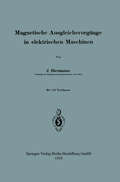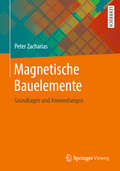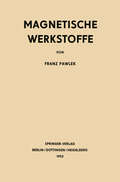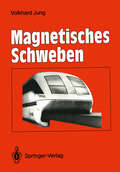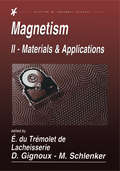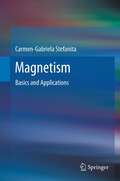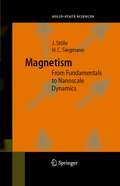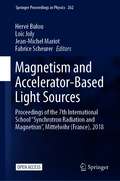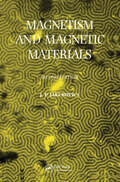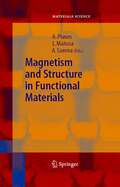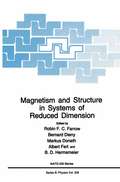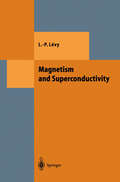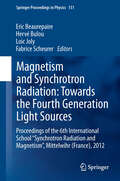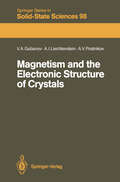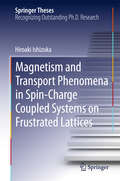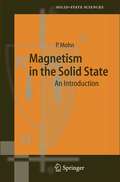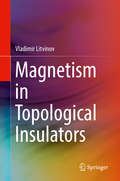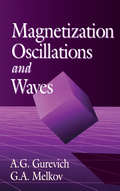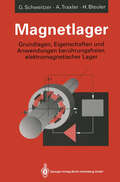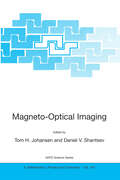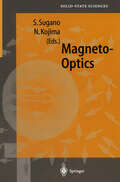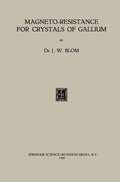- Table View
- List View
Magnetische Ausgleichsvorgänge in elektrischen Maschinen
by Josef BiermannsDieser Buchtitel ist Teil des Digitalisierungsprojekts Springer Book Archives mit Publikationen, die seit den Anfängen des Verlags von 1842 erschienen sind. Der Verlag stellt mit diesem Archiv Quellen für die historische wie auch die disziplingeschichtliche Forschung zur Verfügung, die jeweils im historischen Kontext betrachtet werden müssen. Dieser Titel erschien in der Zeit vor 1945 und wird daher in seiner zeittypischen politisch-ideologischen Ausrichtung vom Verlag nicht beworben.
Magnetische Bauelemente: Grundlagen und Anwendungen
by Peter ZachariasDas Buch behandelt Methoden zur Beschreibung und Gestaltung elektromagnetischer Bauelemente. Dabei werden sowohl lineare als auch nichtlineare Bauelemente behandelt. Für elektrische Simulationen werden auf diese Weise die erforderlichen Ersatzschaltbilder abgeleitet und eine allgemeine Methodik entwickelt. Einflussmöglichkeiten auf Eigenschaften über Materialauswahl, Wicklungsgestaltung und Vormagnetisierung von Abschnitten werden behandelt. Umfangreich wird auf messtechnische Charakterisierung, Modellbildung sowie Fehlermöglichkeiten und Modellgrenzen eingegangen. Im letzten Kapitel werden Beispiele erörtert.
Magnetische Werkstoffe (Reine und angewandte Metallkunde in Einzeldarstellungen #11)
by Franz PawlekDie stürmische Entwicklung auf ferromagnetischem Gebiet und die wachsende Bedeutung der Anwendung magnetischer 'Verkstoffe in der industriellen Technik ließ es schon seit einiger Zeit als wünschenswert erscheinen, eine zusammenfassende Darstellung über diese Fragen hera uszu bringen. Der Verfasser folgte deshalb gern der Aufforderung des Herausgebers, "die Werkstoffe" in einem Band der Sammlung geschlossen zu behandeln. Bei Beschränkung auf dieses wichtige und umfangreiche Teilgebiet der magnetischen 'Verkstoffkunde ging man von der Voraussetzung aus, daß der Industrie mit einem Buch, in dem in der Hauptsache die Anwendungs fragen des Gesamtgebietes gründlich abgehandelt sind, zur Zeit besonders gedient sein wird. Bei der Bearbeitung konnte die Zeitschriftenliteratur der Jahre 1930 bis Ende 1950, die zum größten Teil im Original zur Verfügung stand, berücksichtigt werden. Von den älteren zusammenfassenden Werken ist das Buch "Die ferromagnetischen Legierungen" von 1V. S. MESSKIN und A. KUSSMANN besonders erwähnenswert. Inhaltlich muß vieles in ihm nach dem heutigen Stand als überholt angesehen werden, wenn auch sein Aufbau noch immer als vorbildlich angesprochen werden kann. In einer Reihe weiterer, in der Folgezeit erschienener Bücher werden die Werkstoffe nur an zweiter Stelle behandelt. In dem umfangreichen Buch von R. M. BOZORTH "Ferromagnet,ism", das 1951 in New York heraus kam, wird der heutige Stand des Gesamtgebietes wiedergegeben. Im vorliegenden Band, in dem ein Querschnitt über die Entwicklung der magnetischen Werkstoffe in den letzten 20 Jahren gegeben wird, konnten diese jedoch sehr viel eingehender gewürdigt werden. Das Manuskript des Buches wurde von Herrn Prof. Dr. W.
Magnetisches Schweben
by Volkhard JungDieses Buch behandelt das Magnetische Schweben in seinen drei wichtigen Formen, permanentmagnetisches (PMS), elektromagnetisches (EMS) und elektrodynamisches (EDS) Schweben, dazu die berührungsfreien Antriebe mit Lang- und Kurzstator-Linearmotor und schließlich auch den Gravitationsantrieb, der jedoch nur Energie leihen kann. Dem jetzt im Fernverkehr angewandten elektromagnetischen Schweben wird gleichviel Gewicht gegeben wie den anderen Arten. Das elektrodynamische Schweben (EDS) wird besonders ausführlich behandelt, denn es könnte sein, daß diese einzige stabile Schwebetechnik durch die Entwicklung warmer Supraleiter in Zukunft wieder stärkere Bedeutung gewinnt. Auch werden verfahrenstechnische Anwendungen des EDS angesprochen. Das Buch ist hervorgegangen aus einer Vorlesung an der Universität Karlsruhe. Es wendet sich an alle, die sich über die Magnetschwebetechnik informieren wollen. 99 Zitate aus der Fachliteratur erlauben dem Interessierten leicht den Einstieg in diese Thematik. Eine Einführung in die physikalischen Grundlagen des Magnetischen Schwebens soll die Zuhilfenahme von Lehrbüchern weitgehend überflüssig machen.
Magnetism: II-Materials and Applications
by Etienne Du Trémolet De Lacheisserie Damien Gignoux Michel SchlenkerMagnetism: Basics and Applications
by Carmen-Gabriela StefanitaThis textbook is aimed at engineering students who are likely to come across magnetics applications in their professional practice. Whether designing lithography equipment containing ferromagnetic brushes, or detecting defects in aeronautics, some basic knowledge of 21st century magnetism is needed. From the magnetic tape on the pocket credit card to the read head in a personal computer, people run into magnetism in many products. Furthermore, in a variety of disciplines tools of the trade exploit magnetic principles, and many interdisciplinary laboratory research areas cross paths with magnetic phenomena that may seem mysterious to the untrained mind. Therefore, this course offers a broad coverage of magnetism topics encountered more often in this millenium, revealing key concepts on which many practical applications rest. Some traditional subjects in magnetism are discussed in the first half of the book, followed by areas likely to spark the curiosity of those more interested in today’s technological achievements. Although sometimes some aspects may seem difficult to comprehend at first, bibliography directs the reader to appropriate further study. Throughout the chapters, the student is encouraged to discover the not-so-obvious associations between different magnetics topics, a task that will prove to be at the very least rewarding.
Magnetism: From Fundamentals to Nanoscale Dynamics (Springer Series in Solid-State Sciences #152)
by Joachim Stöhr Hans Christoph SiegmannThis text book gives a comprehensive account of magnetism, one of the oldest yet most vibrant fields of physics. It spans the historical development, the physical foundations and the continuing research underlying the subject. The book covers both the classical and quantum mechanical aspects of magnetism and novel experimental techniques. Perhaps uniquely, it discusses spin transport and magnetization dynamics phenomena associated with atomically and spin engineered nano-structures against the backdrop of spintronics and magnetic storage and memory applications. The book is for students, and serves as a reference for scientists in academia and research laboratories.
Magnetism and Accelerator-Based Light Sources: Proceedings of the 7th International School ‘‘Synchrotron Radiation and Magnetism’’, Mittelwihr (France), 2018 (Springer Proceedings in Physics #262)
by Hervé Bulou Loïc Joly Jean-Michel Mariot Fabrice ScheurerThis open access book collects the contributions of the seventh school on Magnetism and Synchrotron Radiation held in Mittelwihr, France, from 7 to 12 October 2018. It starts with an introduction to the physics of modern X-ray sources followed by a general overview of magnetism. Next, light / matter interaction in the X-ray range is covered with emphasis on different types of angular dependence of X-ray absorption spectroscopy and scattering. In the end, two domains where synchrotron radiation-based techniques led to new insights in condensed matter physics, namely spintronics and superconductivity, are discussed. The book is intended for advanced students and researchers to get acquaintance with the basic knowledge of X-ray light sources and to step into synchrotron-based techniques for magnetic studies in condensed matter physics or chemistry.
Magnetism and Magnetic Materials
by J.P. JakubovicsMagnetic materials have many interesting and important uses. This book discusses the subject of magnetism and magnetic materials at a level suitable for undergraduates studying Materials Science, Physics or Engineering. It gives a brief introduction to the fundamental ideas in magnetism, and then explains the classification of materials
Magnetism and Magnetic Materials
by J.P. JakubovicsMagnetic materials have many interesting and important uses. This book discusses the subject of magnetism and magnetic materials at a level suitable for undergraduates studying Materials Science, Physics or Engineering. It gives a brief introduction to the fundamental ideas in magnetism, and then explains the classification of materials
Magnetism and Structure in Functional Materials (Springer Series in Materials Science #79)
by Antoni Planes Lluís Mañosa Avadh SaxenaMagnetism and Structure in Functional Materials addresses three distinct but related topics: (i) magnetoelastic materials such as magnetic martensites and magnetic shape memory alloys, (ii) the magnetocaloric effect related to magnetostructural transitions, and (iii) colossal magnetoresistance (CMR) and related manganites. The goal is to identify common underlying principles in these classes of materials that are relevant for optimizing various functionalities. The emergence of apparently different magnetic/structural phenomena in disparate classes of materials clearly points to a need for common concepts in order to achieve a broader understanding of the interplay between magnetism and structure in this general class of new functional materials exhibiting ever more complex microstructure and function. The topic is interdisciplinary in nature and the contributors correspondingly include physicists, materials scientists and engineers. Likewise the book will appeal to scientists from all these areas.
Magnetism and Structure in Systems of Reduced Dimension (Nato Science Series B: #309)
by Robin F. C. Farrow Bernard Dieny Markus Donath Albert Fert B. D. HermsmeierThis volume contains the papers presented at the NATO Advanced Research Workshop on "Magnetism and Structure in Systems of Reduced Dimension", held at l'Institut d'Etudes Scientifiques de Cargese - U.M.S. - C.N.R.S. - Universite de Corte Universite de Nice Sophia - Antipolis during June 15-19, 1992. The ordering of papers in the volume reflects the sequence of papers presented at the workshop. The aim was not to segregate the papers into rigidly defmed areas but to group the papers into small clusters, each cluster having a common theme. In this way the parallel, rather than serial, development of areas such as preparation of films, magnetic and structural characterization was highlighted. Indeed the success of the field depends on such parallel development and is assisted by workshops of this nature and the international collaborations which they foster. The organizers and participants of the NATO workshop express their thanks to Mme. Marie-France Hanseier and the staff at l'Institut d'Etudes Scientifiques de Cargese U.M.S. - C.N.R.S. - Universite de Corte - Universite de Nice Sophia - Antipolis for making the workshop and local arrangements a memorable success. Warm thanks are also expressed to Varadachari Sadagopan and Pascal Stefanou for their encouragement and help in making the workshop a reality. We are also grateful to Kristl Hathaway, Larry Cooper and Gary Prinz for advice in developing the workshop program.
Magnetism and Superconductivity (Theoretical and Mathematical Physics)
by Laurent-Patrick LevyThis book was written from lectures given to MSc students following the 'Matter and Radiation' course at the University of Grenoble I. Although magnetism and superconductivity cover a wide area of physics, the course was motivated by a common factor: these phenomena are realisa tions of thermodynamic states which break certain continuous symmetries. In the case of magnetism, they break rotational invariance. In the case of superconductivity, they break gauge invariance. The aim of the course was to bring out the importance of broken symmetries in condensed matter physics. The book can be understood with minimal prerequisites and the math ematical techniques used are fairly elementary. However, a basic knowledge of spin and angular momentum is essential, since quantum mechanics lies at the heart of both magnetism and superconductivity. Chapter 2 reviews the main points. The first chapter explains how thermodynamic functions are constructed in the presence of a magnetic field. As the book has two parts, Magnetism (I) and Superconductivity (II), these will be specified between brackets in cross-references to sections and chapters. I have made a particular effort to present phenomena in magnetism and superconductivity by starting with concrete examples. Some technological applications of superconductivity have also been described.
Magnetism and Synchrotron Radiation: Proceedings of the 6th International School “Synchrotron Radiation and Magnetism”, Mittelwihr (France), 2012 (Springer Proceedings in Physics #151)
by Eric Beaurepaire Hervé Bulou Loic Joly Fabrice ScheurerAdvances in the synthesis of new materials with often complex, nano-scaled structures require increasingly sophisticated experimental techniques that can probe the electronic states, the atomic magnetic moments and the magnetic microstructures responsible for the properties of these materials.At the same time, progress in synchrotron radiation techniques has ensured that these light sources remain a key tool of investigation, e.g. synchrotron radiation sources of the third generation are able to support magnetic imaging on a sub-micrometer scale.With the Sixth Mittelwihr School on Magnetism and Synchrotron Radiation the tradition of teaching the state-of-the-art on modern research developments continues and is expressed through the present set of extensive lectures provided in this volume. While primarily aimed at postgraduate students and newcomers to the field, this volume will also benefit researchers and lecturers actively working in the field.
Magnetism and the Electronic Structure of Crystals (Springer Series in Solid-State Sciences #98)
by Vladimir A. Gubanov Alexandr I. Liechtenstein Andrei V. PostnikovThe quantum theory of magnetism is a well-developed part of contemporary solid-state physics. The basic concepts of this theory can be used to describe such important effects as ferromagnetic ordering oflocalized magnetic moments in crystals and ferromagnetism of metals produced by essentially delocalized electrons, as well as various types of mutual orientation of atomic magnetic moments in solids possessing different crystal lattices and compositions. In recent years,the spin-fluctuational approach has been developed, which can overcome some contradictions between "localized" and "itinerant" models in the quantum mechanics of magnetic crystals. These are only some of the principal achievements of quantum magnetic theory. Almost all of the known magnetic properties of solids can be qualitat ively explained on the basis of its concepts. Further developments should open up the possibility of reliable quantitative description of magnetic properties of solids. Unfortunately, such calculations based on model concepts appear to be very complicated and, quite often, not definite enough. The rather small number of parameters of qualitative models are usually not able to take into account the very different types of magnetic interactions that appear in crystals. Further development of magnetic theory requires quantitative information on electronic wave function in the crystal considered. This can be proved by electronic band structure and cluster calculations. In many cases the latter can be a starting point for quantitative calculations of parameters used in magnetic theory.
Magnetism and Transport Phenomena in Spin-Charge Coupled Systems on Frustrated Lattices (Springer Theses)
by Hiroaki IshizukaIn this thesis, magnetism and transport phenomena in spin-charge coupled systems on frustrated lattices are theoretically investigated, focusing on Ising-spin Kondo lattice models and using a combination of Monte Carlo simulation and other techniques such as variational calculations and perturbation theory. The emphasis of the study is on how the cooperation of spin-charge coupling and geometrical frustration affects the thermodynamic properties of the Kondo lattice models; it presents the emergence of various novel magnetic states, such as the partial disorder, loop-liquid, and spin-cluster states. The thesis also reveals that the magnetic and electronic states and transport properties of these models demonstrate peculiar features, such as Dirac half-metals, anomalous Hall insulators, and spin Hall effects. Study of novel magnetic states and exotic transport phenomena in Kondo lattice systems is a field experiencing rapid progress. The interplay of charge and spin degrees of freedom potentially gives rise to various novel phases and transport phenomena which are related to strongly correlated electrons, frustrated magnetism, and topological states of matter.The results presented in this thesis include numerical calculations that are free from approximations. Accordingly, they provide reliable reference values, both for studying magnetism and transports of related models and for experimentally exploring novel states of matter in metallic magnets.
Magnetism in the Solid State: An Introduction (Springer Series in Solid-State Sciences #134)
by Peter MohnThis book presents a phenomenological approach to the field of solid state magnetism. It surveys the various theories and discusses their applicability in different types of materials. The text will be valuable as a text for graduate courses in magnetism and magnetic materials.
Magnetism in Topological Insulators
by Vladimir LitvinovThis book serves as a brief introduction to topological insulator physics and device applications. Particular attention is paid to the indirect exchange interaction mediated by near surface Dirac fermions and the spin texture this interaction favors. Along with useful information on semiconductor material systems, the book provides a theoretical background for most common concepts of TI physics. Readers will benefit from up to date information and methods needed to start working in TI physics, theory, experiment and device applications.Discusses inter-spin interaction via massless and massive Dirac excitations;Includes coverage of near-surface spin texture of the magnetic atoms as related to their mutual positions as well to their positions with respect to top and bottom surfaces in thin TI film;Describes non-RKKY oscillating inter-spin interaction as a signature of the topological state;Explains the origin of the giant Rashba interaction at quantum phase transition in TI-conventional semiconductors.
Magnetism: A Synchrotron Radiation Approach (Lecture Notes in Physics #697)
by Eric Beaurepaire Hervé Bulou Fabrice Scheurer Jean-Paul KapplerThis volume contains the edited lectures of the fourth Mittelwihr school on 'Magnetism and Synchrotron Radiation'. This series of events introduces graduate students and nonspecialists from related disciplines to the field of magnetism and magnetic materials with emphasis on synchrotron radiation as an experimental tool of investigation. These lecture notes present in particular the state of the art regarding the analysis of magnetic properties of new materials.
Magnetization Oscillations and Waves
by A.G. Gurevich G.A. MelkovWritten by two well-known researchers in the field, this useful reference takes an applied approach to high frequency processes including oscillations and waves in ferromagnets, antiferromagnets, and ferrimagnets. Problems evaluated include ferromagnetic and antiferromagnetic resonances, spin waves, nonlinear processes, and high frequency manifestations of interactions between the magnetic system and other systems of magnetically ordered substances as elastic waves and charge carriers.Unlike previous monographs on this subject, which are highly theoretical and written for very advanced readers, this book requires only an average college background in mathematics and experimental physics. It will be a valuable addition to the library of engineers and scientists in research and development for communications applications, and scientists interested in nonlinear magnetic phenomena. It also serves as an excellent introduction to the topic for newcomers in the field.Magnetization Oscillations and Waves not only presents results but also shows readers how to obtain them; most formulas are derived with so many details that readers can reproduce them. The book includes many summaries and tables and detailed references to significant work in the area by European researchers.
Magnetization Oscillations and Waves
by A.G. Gurevich G.A. MelkovWritten by two well-known researchers in the field, this useful reference takes an applied approach to high frequency processes including oscillations and waves in ferromagnets, antiferromagnets, and ferrimagnets. Problems evaluated include ferromagnetic and antiferromagnetic resonances, spin waves, nonlinear processes, and high frequency manifestations of interactions between the magnetic system and other systems of magnetically ordered substances as elastic waves and charge carriers.Unlike previous monographs on this subject, which are highly theoretical and written for very advanced readers, this book requires only an average college background in mathematics and experimental physics. It will be a valuable addition to the library of engineers and scientists in research and development for communications applications, and scientists interested in nonlinear magnetic phenomena. It also serves as an excellent introduction to the topic for newcomers in the field.Magnetization Oscillations and Waves not only presents results but also shows readers how to obtain them; most formulas are derived with so many details that readers can reproduce them. The book includes many summaries and tables and detailed references to significant work in the area by European researchers.
Magnetlager: Grundlagen, Eigenschaften und Anwendungen berührungsfreier, elektromagnetischer Lager
by Gerhard Schweitzer Alfons Traxler Hannes BleulerMagneto-Optical Imaging (NATO Science Series II: Mathematics, Physics and Chemistry #142)
by Tom H. Johansen Daniel V. ShantsevMagneto-Optical Imaging has developed rapidly over the last decade to emerge as a leading technique to directly visualise the static and dynamic magnetic behaviour of materials, capable of following magnetic processes on the scale of centimeters to sub-microns and at timescales from hours to nanoseconds. The images are direct, real-time, and give space-resolved information, such as ultrafast magnetic processes and revealing the motion of individual vortices in superconductors. The book is a fully up-to-date report of the present status of the technique.
Magneto-Optics (Springer Series in Solid-State Sciences #128)
by Satoru Sugano Norimichi KojimaEdited by two pioneers of magneto-optics, this book is designed to provide graduate students and researchers with an introductory state-of-the-art review of recent developments in this subject. The field encompasses important areas in solid-state physics, chemical physics and electrical engineering. The book deals with optical spectroscopy of paramagnetic, antiferromagnetic, and ferromagnetic materials, photo-induced magnetism and their applications to opto-electronics.
